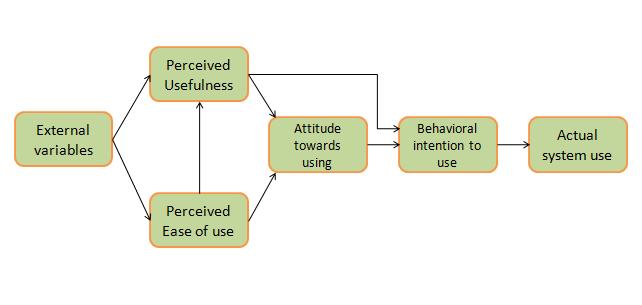We are experiencing the fourth industrial revolution. As technology is considered the key factor to change the human lifestyle, it is important to identify how well people are adapting to the changing technological advancements. Technology Acceptance Model (TAM) is an Information Systems theory that shows how well the users of new technology are accepting to use the technology. This model was developed and introduced by Fred Davis and Richard Bagozzi. This can be considered as one of the most frequently used models to analyze the new technology acceptance.
Technology acceptance describes that when a person is presented with a certain new technology, several factors determine whether the person is going to use the technology, how they are going to use, and when it will be used. It is considered that new technology should be both usable and useful to the customer. Based on that there are two main components that are measured in TAM.
- Perceived Usefulness
- Perceived ease of use
Perceived usefulness
This is one of the two main variables in the Technology Acceptance Model. Perceived usefulness can be identified as the extent to which the user believes that the new technology/ system will boost their productivity. It can be personal productivity or job productivity which will improve the individual’s performance. The system should have the ability to enhance the efficiency and the effectiveness of the work. The individual who uses the system/ technology should get the feeling of usefulness after using the system. This is purely the customer’s perception of the outcome of using the new technology/system.
Perceived ease of use
Perceived ease of use is the second variable of the Technology Acceptance Model. It explains that the new system should help the individual to perform their required task in an easy and fast manner. Apart from that, it is also stated that the individual should be able to operate the system/technology easily with minimum training. The interaction between the individual and the system should be clear and understandable. The person should be able to understand the system and the system should be capable to understand the instructions given by the person.
The system should be capable to have flexibility when necessary. The technological requirements can change based on the customer requirement and the flexibility in the system is vital. All these factors create a perceived use in a system/new technology.
This perceived usefulness and the perceived ease of use together create an impact on the customer’s attitude towards the use of the system. As the usefulness and ease of use are considered two main factors any customer would consider before using or adopting a certain technology, it creates a huge impact on the customer’s willingness to use the system.
Eg: Before getting registered for the internet banking service given by a bank, any customer would consider whether the internet banking facility will help to increase the productivity in the banking activities and whether the internet banking platform is hassle-free, easy, and fast. If these factors are satisfactory, the customer will register for the facility and continue to use it. If the customer feels like the internet banking platform is not providing ease of use or usefulness, they will ignore the facility and move to another available option.
The customer attitude towards the use of technology can lead to behavioral intention to use the technology. This is about the customer’s planning to use the product or not to use the product. Customer’s attitudes towards the use as well as the perceived usefulness have an impact on the behavioral intention of using the product. This leads to the actual usage of the product. This is the final stage of the Technology Acceptance Model where the customer uses the system or not using the system.
It is identified that the customer’s trust is also an important factor in the process of Technology Acceptance. However, in the Technology Acceptance Model, the trust factor is not considered as a major element.
Finally, it is identified that the organizations use this model to analyze the use of new technology adaption and to achieve a competitive advantage by understanding customer behavior.

